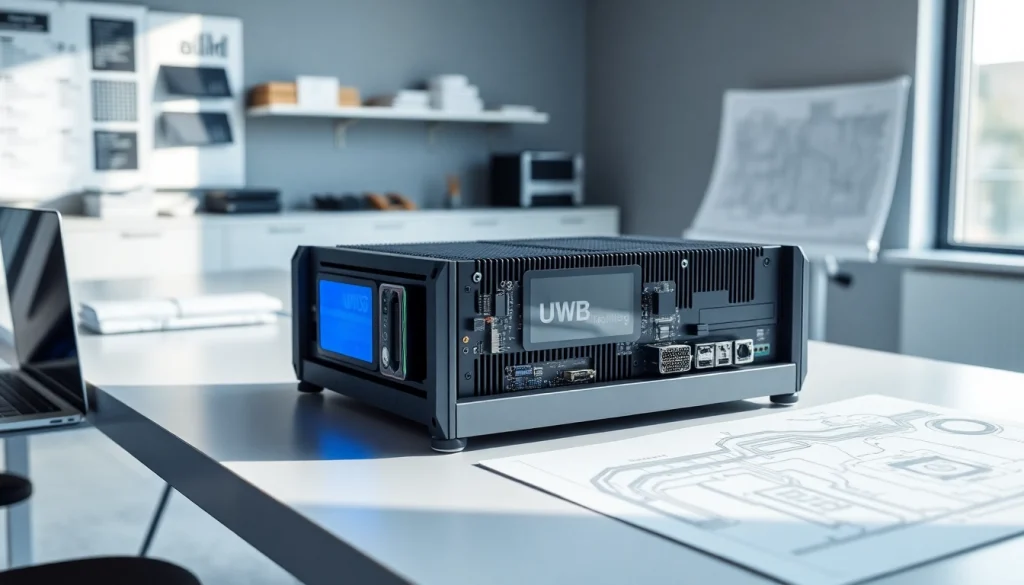Understanding UWB Modules
What is a UWB Module?
Ultra-Wideband (UWB) technology has emerged as a significant advancement in wireless communication, increasingly popular in various applications due to its unique characteristics. A UWB module is a component that utilizes this technology to enable precise location tracking and data exchange over short distances. This module operates over a wide frequency spectrum, typically from 3.1 to 10.6 GHz, which allows it to transmit data at very high speeds while maintaining low power consumption. The definition may seem technical, but it highlights the core capabilities of UWB systems—enhancing communication with remarkably high levels of precision.
UWB technology stands out from other wireless communication technologies by its ability to transmit data over a much broader frequency range. This capability makes UWB modules particularly effective in environments cluttered with interference, as they can leverage multiple channels simultaneously. As a result, UWB has found applications in diverse fields ranging from consumer electronics to automotive safety systems. The technology offers a level of accuracy that is particularly valuable for location-based services or applications requiring high-speed data transmission.
For those interested in learning more about UWB technology and its components, the UWB module serves as an essential part of this revolutionary communication framework.
Key Features of UWB Technology
UWB technology features several critical attributes that enhance its functionality and applicability. Here are some of the most notable features:
1. High Precision and Accuracy: One of the most remarkable features of UWB modules is their ability to provide high precision in location tracking, with accuracies within a few centimeters. This level of precision is crucial in applications like asset tracking, indoor navigation, and smart home systems, where accuracy directly affects performance.
2. Broad Frequency Range: UWB operates across a wide frequency range, utilizing multiple channels for data transmission, which allows it to avoid interference and maintain robust communication.
3. Low Power Consumption: UWB technology is known for its low energy usage, making it ideal for battery-operated devices. Unlike other wireless standards, UWB can facilitate continuous operation for extended periods without frequent recharging or battery replacements.
4. Immunity to Interference: The broad spectrum used by UWB enables it to coexist with other wireless technologies without considerable interference, providing a more reliable communication option in crowded frequency environments.
5. Multipath Resilience: UWB’s ability to leverage signals reflected off various surfaces allows for more accurate positioning and better signal integrity when navigating complex environments.
These features make UWB modules exceptionally versatile for a variety of applications, including those in positioned-dependent computing and data transfer.
How UWB Modules Work
The operational mechanism of UWB modules is fundamentally different from conventional wireless communication systems. UWB technology utilizes short-duration pulses that convey data by modulating these signals over a broad frequency spectrum. Here’s how they work in detail:
– Pulse Generation: UWB modules generate very short pulses, typically less than a nanosecond, which carry the information being transmitted. This allows UWB to cover a large bandwidth efficiently.
– Wideband Transmission: The pulses are spread over a vast frequency range. During transmission, multiple channels are active, which enhances data security and reduces the likelihood of signal interference from other sources.
– Time of Flight Measurement: UWB systems measure the time it takes for a radio pulse to travel from the transmitter to the receiver, known as the Time of Flight (ToF). This measurement is the basis for calculating the distance between devices, enabling accurate positioning.
– Data Encoding and Decoding: Data is encoded into the transmitted pulses, where the information is received, and decoding takes place at the receiver end. UWB employs sophisticated algorithms to filter noise and eliminate interference, ensuring the integrity of the received data.
These mechanisms combine to create a robust technology that offers not only precise positioning capabilities but also high-speed data transmission—a crucial combination for modern applications across various sectors.
Applications of UWB Modules
UWB technology is revolutionizing numerous industries by providing innovative solutions in various applications. Below are some prominent domains where UWB modules are making a significant impact.
UWB in Location Tracking
Location tracking is one of the most prominent applications of UWB technology. The high precision of UWB modules allows for accurate indoor positioning systems, which are indispensable in environments like shopping malls, airports, and hospitals.
Unlike GPS that struggles in indoor locations, UWB can pinpoint a user’s location precisely within a confined space. This capability enables businesses to enhance customer experiences through personalized services based on real-time location data, such as assisting customers with directions to specific stores or tracking inventory locations efficiently.
– Asset Tracking: UWB systems are being employed for asset management in industries such as logistics and manufacturing. Companies can monitor the location of high-value assets in real-time, resulting in improved efficiency and reduced losses.
– Healthcare Monitoring: UWB technology is increasingly being used in healthcare for monitoring patients’ exact locations within hospitals, enhancing their safety and accelerating response times from medical staff.
UWB for Smart Home Integration
As part of the growing trend towards smart home technology, UWB modules are integrating with various devices to improve connectivity and enhance user experience. UWB enables seamless communication between devices such as smart locks, lights, and security cameras.
– Smart Lock Systems: With UWB, smart door locks can provide keyless entry based on proximity, allowing doors to open automatically as the user approaches. This feature enhances convenience and provides a higher level of security since the system can distinguish between authorized users and potential intruders.
– Device Interconnection: UWB’s precision offers the possibility of controlling multiple smart devices simultaneously. Users can command different systems from a smartphone without the need for complex setups or connections, utilizing features like room mapping to intelligently manage their environments.
The integration of UWB technology into smart homes promises to make living spaces more automated, secure, and efficient.
UWB in Automotive Technology
The automotive sector is experiencing a significant transformation through the implementation of UWB technology, offering innovative safety and navigation solutions.
– Keyless Entry and Start Systems: Modern vehicles increasingly use UWB technology for advanced keyless entry systems. The precise location tracking enabled by UWB allows for secure vehicle access, reducing the chances of unauthorized entry compared to traditional RFID systems.
– Collision Avoidance: UWB modules are being integrated into advanced driver-assistance systems (ADAS) to improve the vehicle’s ability to detect nearby objects, enabling features such as automatic braking and collision avoidance. This application enhances overall driving safety, making roads safer for both drivers and pedestrians.
– Parking Assistance: UWB technology can assist in parking systems, providing accurate distance measurements to help drivers maneuver into tight spots easily. Advanced parking systems can utilize UWB data to automate the parking process, which is particularly beneficial in crowded urban environments.
The impact of UWB technology in automotive applications signals a shift towards more intelligent, safer vehicles ready to integrate with the broader smart ecosystem.
Advantages of UWB Technology
In comparison to traditional wireless technologies, UWB offers distinct advantages that make it an attractive option for various applications.
High Precision and Accuracy
At the forefront of UWB technology’s advantages is its unparalleled precision in location tracking. UWB provides accuracy levels within centimeters, vastly superior to technologies like Bluetooth and Wi-Fi. This incredible precision is crucial for applications requiring detailed spatial awareness, such as asset tracking, indoor navigation, and safety solutions.
The implication of high-accuracy measurements is profound; businesses can reduce losses and operational inefficiencies by precisely locating resources while enhancing customer experiences in environments such as retail spaces and hospitals.
Low Power Consumption
UWB modules excel in power efficiency, fundamentally benefiting applications where devices rely on battery power. Traditional wireless protocols often consume significant energy, which limits their viability in devices designed for long-term use without frequent recharging.
The low power consumption characteristic of UWB allows devices to maintain a long operational life, making it suitable for a growing array of portable devices in the marketplace. Innovations in battery technology combined with UWB’s energy efficiency could lead to the development of new applications previously deemed impractical.
Security Benefits of UWB Modules
Robust security features are inherent in UWB technology, primarily due to its unique method of data transmission. UWB communication is inherently more secure than many conventional wireless technologies because the wide frequency range and short pulses make it difficult to intercept signals, providing a layer of protection from eavesdropping.
Additionally, UWB’s ability to accurately measure distance adds another layer of security for applications like access control. Smart locks using UWB can authenticate users based on their proximity, allowing seamless access for legitimate users while deterring potential intrusion attempts.
In a world increasingly concerned with data security, the advantages of UWB technology present a compelling alternative for developers and businesses alike.
Comparing UWB Modules with Other Technologies
While UWB technology presents unique benefits, it’s essential to compare it with other prevailing technologies to understand its positioning in the market better.
UWB vs. Bluetooth
Bluetooth technology has long been a staple in wireless communication. However, when it comes to precision, UWB takes the lead. Bluetooth typically provides location accuracy within a range of several meters, far less precise than UWB’s centimeter-level accuracy.
Moreover, UWB’s lower power consumption compared to Bluetooth makes it ideal for applications requiring continuous operation without frequent recharging. However, Bluetooth generally has a more extensive range, making it suitable for broader communication needs but at the expense of precision.
UWB vs. Wi-Fi
Wi-Fi technology dominates in providing internet connectivity but falls short in terms of location accuracy. While Wi-Fi can deliver some degree of positioning, typically it falls within several meters of accuracy, unlike UWB’s pinpoint precision.
UWB excels in environments where accurate indoor positioning and low power consumption are critical. On the other hand, Wi-Fi is better suited for broader data transmission needs, particularly where internet access is required rather than precise location determination.
UWB vs. RFID
Radio Frequency Identification (RFID) technology is widely utilized for tracking objects through tags. While RFID is effective for low-cost and long-range applications, its accuracy is considerably inferior to that of UWB.
UWB provides distance measurements with high precision, making it ideal for applications that require intricate spatial information. Moreover, UWB can transmit larger data payloads than traditional RFID systems, enabling more complex communication protocols.
The enhanced capabilities of UWB technology create new competitive advantages in many cases where precise tracking and positioning are essential.
Future of UWB Technology
As UWB technology develops, it will likely play a vital role in the future of connected systems and IoT devices. Here are some emerging trends and challenges for the future of UWB technology:
Emerging Trends in UWB Development
The landscape of technology is characterized by rapid evolution, and UWB is no exception. Key emerging trends include:
– Integration with 5G: As 5G networks expand, the integration of UWB technology with 5G communication systems is on the rise, enabling wider applications in smart cities and IoT deployments.
– Enhanced User Experiences: Innovations in UWB technology will drive the development of advanced user interfaces in smart devices that are more context-aware and responsive based on a user’s location and interactions.
– Increased Adoption in Consumer Electronics: The rising popularity of smart home devices, wearables, and personal gadgets will lead to broader acceptance of UWB technology among consumers, promoting new usage scenarios.
The Role of UWB in IoT
UWB stands poised to become a pivotal technology in the IoT ecosystem. Its ability to facilitate precise location tracking and high-speed data communication aligns perfectly with the growing need for interconnected devices.
In the context of IoT, UWB can enhance asset tracking in warehouses, optimize supply chain logistics, and provide seamless experiences in smart environments. Furthermore, as devices increasingly become interconnected, UWB could enhance security protocols, making IoT systems more robust against unauthorized access.
Future Challenges and Opportunities
Despite the promising outlook for UWB technology, certain challenges may hinder its adoption:
– Market Awareness: A lack of understanding of UWB technology among consumers and businesses may slow its integration into existing systems. Effective promotion and education will be essential for widespread acceptance.
– Regulatory Constraints: Wireless communication technologies must comply with various regulations, and navigating these requirements can be a challenge for UWB developers aiming to bring innovative products to market.
– Compatibility with Existing Systems: Integrating UWB with existing wireless networks and systems may pose technical challenges, demanding development efforts to create compatible devices and applications.
Nonetheless, these challenges also present opportunities for growth and innovation in the UWB landscape. With continual advancements and rising demand, the future of UWB technology looks bright, positioned to transform industries significantly.





